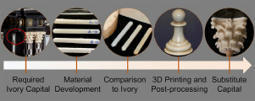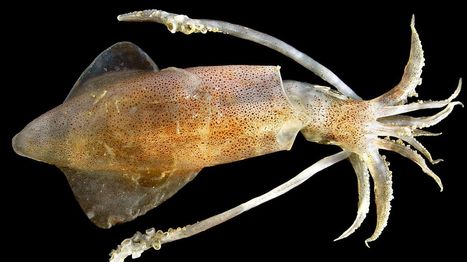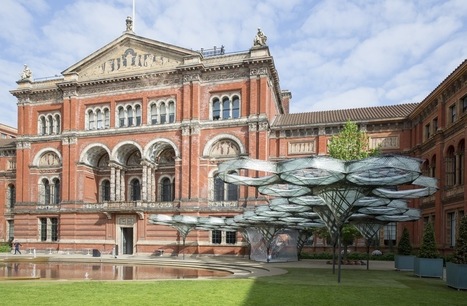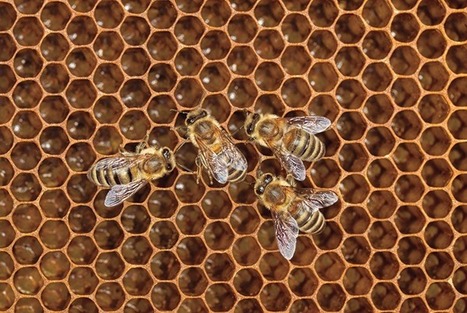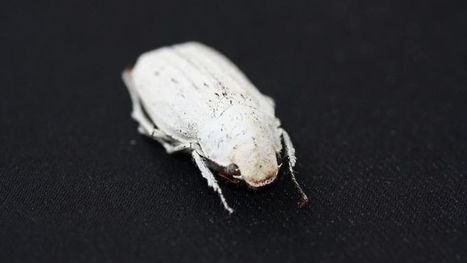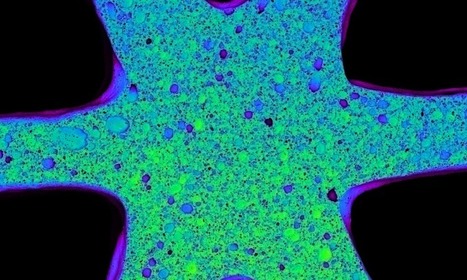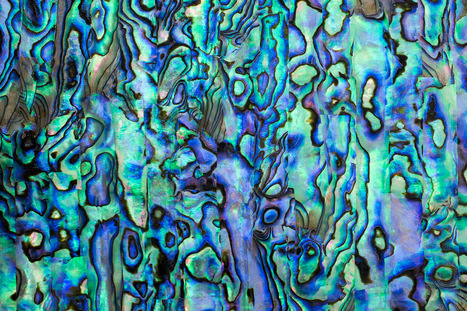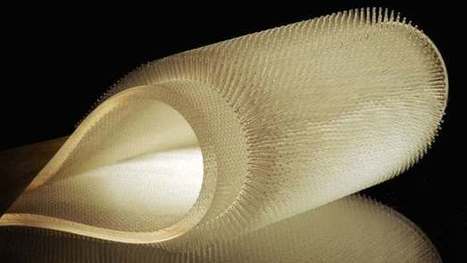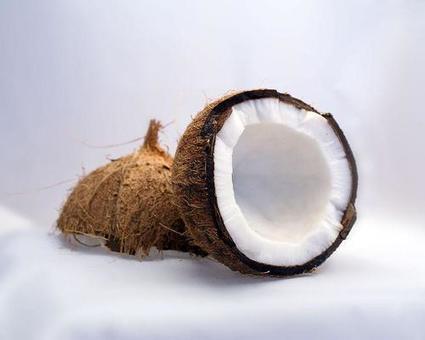 Your new post is loading...
 Your new post is loading...
"Through history, numerous art, religious and every-day objects were carved from ivory because of its aesthetic appearance, convenient workability and its durability. Since the ivory trading ban was passed in 1989, many natural and synthetic materials were introduced as a replacement, but these are typically only available in bulk. …The newly developed substitute material called "Digory" is processible with an additive manufacturing technique that derived from stereolithography."
"The sea urchin spines are mostly made of calcite, usually a very brittle and fragile material. In the case of the sea urchin, however, the spines are much more durable than the raw material alone. The reason for its strength is the way that nature optimises materials using a brick wall-style architecture. A research team headed by Prof. Helmut Colfen, successfully synthesised cement at the nano-level according to this "brick and mortar principle". During this process, macro-molecules were identified that take on the function of mortar, affixing the crystalline blocks to each other on the nano-scale, with the blocks assembling themselves in an ordered manner. The aim is to make cement more durable."
Researchers at Purdue University, West Lafayette, have developed a new technology called “organismoids”, devices created from a ceramic material that mirror animal memory by learning to forget unimportant memories while retaining important ones.
The spatial distribution of fibers in hollow bamboo cylinders is optimized to reinforce flexural rigidity, a new finding that sheds light on biomimetic approaches in the development of materials.
Light and tough, bamboo is widely used as a natural, functional material in Japan and other Asian countries. Bamboo is light because of its hollow structure, which allows the plant to grow faster with small amounts of woody parts and expose itself to sunlight above other trees.
"Extending the limit of the classical microscope's resolution has been the holy grail of microscopy for over a century. Physical laws of light make it impossible to view objects smaller than 200nm – the smallest size of bacteria – using a normal microscope alone. However, superlenses that enable us to see beyond the current magnification have been the goal since the turn of the millennium.
After a team at Bangor University's School of Electronic Engineering used a nanobead-derived superlens to break the perceived resolution barrier, the same team has achieved another world first. The team, led by Dr Zengbo Wang, and in colloboration with Professor Fritz Vollrath's silk group at Oxford University's Department of Zoology, has used a naturally occurring material – dragline silk of the golden web spider – as an additional superlens, applied to the surface of the material to be viewed, that provides an additional 2-3 times magnification. This is the first time that a naturally occurring biological material has been used as a superlens."
"Some water ferns can absorb large volumes of oil within a short time, because their leaves are strongly water-repellent and, at the same time, highly oil-absorbing. Researchers of KIT, together with colleagues of Bonn University, have found tha the oil-binding capacity of the water plant results from the hairy microstructure of its leaves. It is now used as a model to further develop the new Nanofur material for the environmentally friendly cleanup of oil spills."
2Protective clothing is critical to the health and safety of workers who handle hazardous chemicals. A new fabric coating promises to not only neutralize toxins, but also to heal tears and holes on its own while the clothes go through the laundry. The coating, developed by a team of researchers from Penn State and Drexel University, is derived from proteins that make up the rings of teeth on squid suckers."
A biological material that has existed for millions of years may find new applications in modern electronics. A team of scientists from UC Santa Cruz, the University of Washington, and the Benaroya Research Institute at Virginia Mason discovered that shark “jelly” is the highest proton conductive biological substance ever found, according to GizMag. In plain English, that means the material is extremely good at detecting weak electrical signals from great distances away — something that scientists and engineers believe could be useful in future sensor design.
Scientists have discovered a previously unknown property of spider silk, and used it to create a remarkable new “hybrid” material. The new bio-inspired thread, which acts like both a solid and a liquid, could lead to a host of new materials and technologies.
Researchers at the University of California, Riverside and Purdue University have used the mantis shrimp as inspiration for a new 3D printed material. The crustacean’s club-like appendage, used to beat prey, consists of an unusual herringbone pattern, which the researchers synthetically replicated.
“An elytron is very delicate and super lightweight, because after all, the beetle still needs to fly,” says Achim Menges, an architect and professor at the University of Stuttgart. “At the same time it’s very robust and exceptionally high performance.”
It was these elytra, the fibrous structures in the forewing shells of flying beetles, that inspired the Elytra Filament Pavilion.
"How do bees do it? The honeycombs in which they store their amber nectar are marvels of precision engineering, an array of prism-shaped cells with a perfectly hexagonal cross-section. The wax walls are made with a very precise thickness, the cells are gently tilted from the horizontal to prevent the viscous honey from running out, and the entire comb is aligned with the Earth’s magnetic field. Yet this structure is made without any blueprint or foresight, by many bees working simultaneously and somehow coordinating their efforts to avoid mismatched cells."
"Airbus and its subsidiary APWorks, in collaboration with Autodesk-owned architecture firm The Living, has started 3D printing the world’s largest metal 3D printed airplane part. The jet partition, 3D printed in a high-tech alloy called “Scalmalloy”, is 45% lighter than current partitions. [...] To create the most durable and lightweight design possible, the project team sought inspiration from nature. Bionics, which involves examining natural mechanics to see how they could be mimicked in technological devices, has been crucial in the production of the 3D printed component. The jet partition was created with custom algorithms, which generated a design that mimics cellular structure and bone growth. Airbus has also been exploring weight-saving aircraft structures based on the construction of super-strong water lilies, and torsion springs based on fish jaws."
|
"Scientists have engineered perhaps the whitest natural substance, using the same physics behind one ghostly white Southeast Asian beetle. White and black feel like opposites for a reason. Black-colored things absorb nearly all of the light that strikes their surface, while white things send the light back, scattered equally at all wavelengths. A team of European scientists have essentially created the whitest paper using this physical property."
"Nature does amazing things with limited design materials. Grass, for example, can support its own weight, resist strong wind loads, and recover after being compressed. The plant's hardiness comes from a combination of its hollow, tubular macrostructure and porous microstructure. These architectural features work together to give grass its robust mechanical properties. Inspired by natural cellular structures, researchers at the Harvard John A. Paulson School of Engineering and Applied Sciences (SEAS), the Wyss Institute for Biologically Inspired Engineering at Harvard University, and MIT have developed a new method to 3D print materials with independently tunable macro-and microscale porosity using a ceramic foam ink."
"It’s a technicolour dreamcoat for your crisp packet – a strong, flame-retardant and airtight new material that mimics mother of pearl. The natural version, also called nacre, is found on the inner shell of some molluscs, where it is built up of layers of the mineral aragonite separated by organic polymers such as chitin. It is remarkably strong, without being brittle or dense. We would like to use nacre and similar materials as a protective coating in many situations."
Even though they don't have a thick layer of blubber, animals such as beavers and sea otters are still able to stay warm when diving in frigid waters. How do they do it? Well, they trap an insulating layer of air between the hairs of their fur. MIT scientists have taken that concept and run with it (or swum with it), creating a bioinspired material that could be used to make lighter, warmer wetsuits.
"Spider silk is well-known for its unusual combination of being both lightweight and extremely strong—in some cases, stronger than steel. Due to these properties, researchers have been developing spider-silk-inspired materials for potential applications such as durable yet lightweight clothing, bullet-proof vests, and parachutes. But so far, the acoustic properties of spider webs have not yet been explored. Now in a new study, a team of researchers from Italy, France and the UK has designed an acoustic metamaterial (which is a material made of periodically repeating structures) influenced by the intricate spider web architecture of the golden silk orb-weaver, also called the Nephila spider."
Photo details: An orb-weaving spider (Nephila clavipes), by Ianaré Sévi [CC BY 3.0], via Wikimedia Commons.
Scientists in China have designed a smart material that rapidly switches from one shape to anotherjust like a Venus flytrap plant snaps close when trapping prey.
Inspired by carnivorous plant’s movement, researchers have been designing polymers that rapidly change shape in response to external stimuli. However, the snapping process is usually irreversible, which has so far limited the materials’ practical potential.
"Coconut palms can grow as high as 30m, and when the ripe fruits fall to the ground their walls must protect them from splitting open. To protect the internal seed, coconuts have a structure of three layers which allow them to withstand heavy impacts. The university’s Plant Biomechanics Group believes this specialised structure could be applied in architecture, and has been working with civil engineers and material scientists to develop this idea as part of a programme called Biological Design and Integrative Structures. [...] The group found that the ladder-like design of vessels in the coconut’s inner endocarp layer “dissipates energy via crack deflection," meaning newly-developed cracks created by an impact don't run directly through the hard shell, but are diverted and stop before the crack separates the fruit. "
"Charles Darwin was the first to observe that Ivy exudes a liquid adhesive that helps it to cling to surfaces. Now researchers at Ohio State University have identified the protein that allows Ivy to stick. Nanospherical arabinogalactan proteins (AGPs) allow Ivy’s adhesive to enter nanoscale openings rather than just coating surfaces. Curing takes place due to calcium-driven electrostatic interactions among carboxyl groups of the AGPs and pectic acids. As water evaporates from the adhesive, chemical bonds are formed between adhesive and substrate. The researchers say that their discovery opens up the possibility of applying its findings to the development of adhesives for a wide range of applications ranging from medical adhesives to coatings and even cosmetics."
"A team of scientists at the Wyss Institute for Biologically Inspired Engineering at Harvard University and the Harvard John A. Paulson School of Engineering and Applied Sciences has evolved their microscale 3D printing technology to the fourth dimension, time. Inspired by natural structures like plants, which respond and change their form over time according to environmental stimuli, the team has unveiled 4D-printed hydrogel composite structures that change shape upon immersion in water."
The mantis shrimp is a small, multi-coloured marine crustacean, with a number sporting fist-like appendage called a dactyl club. This particular variety of mantis shrimp is known as a smasher, as it crushes its prey with its club. Through the study of these creatures, researchers at University of California Riverside and Purdue University, USA, have taken steps toward developing ultra strong composite materials based on the unique herringbone structure within the dactyl club’s outer layer.
Looking for skis to maximize the fun as you hurtle down the slopes? The ideal ski can withstand high levels of pressure in turns yet also be easy to maneuver. These two features usually require two different types of skis: the rigid skis preferred by expert skiers or the flexible ones that intermediate skiers opt for. But a new type of ski offers a two-in-one solution thanks to a design based on turtle scales.
"Additive manufacturing shows great promise for making things in a way that more closely resembles natural form, but some of the below strategies are worth investigating to reduce or eliminate toxicity and to make more functional products.".
|





 Your new post is loading...
Your new post is loading...
